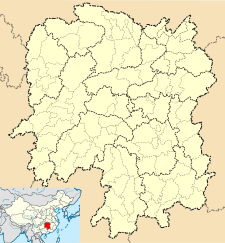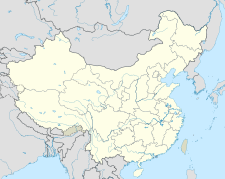Former residence of Xu Guangda
| Former Residence of Xu Guangda | |
|---|---|
许光达故居 | |
 Former Residence of Xu Guangda | |
| General information | |
| Type | Traditional folk houses |
| Location | Huangxing Town, Changsha County, Hunan |
| Country | China |
| Coordinates | 28°08′30″N 113°05′49″E / 28.141725°N 113.096838°E |
| Completed | 1908 |
| Opened | 2005 |
| Renovated | 2005 |
| Technical details | |
| Floor area | 184 m2 (1,980 sq ft) |
The former residence of Xu Guangda (simplified Chinese: 许光达故居; traditional Chinese: 許光達故居; pinyin: Xǔ Guāngdá Gùjū) was built in the late Qing dynasty in Huangxing Town, Changsha County, Hunan, China where a People's Liberation Army general who was conferred the Da jiang (Grand General) rank, Xu Guangda, was born.[1][2] It has a building area of about 184 m2 (1,980 sq ft), embodies buildings such as the old houses and the Exhibition Room. It is currently a significant tourist attraction in Changsha.
History
[edit]The residence was built in the 34th Year of Emperor Guangxu (1908) in the Qing Dynasty with 14 rooms. On 19 November 1908, Xu Guangda was born in its front room.[3] In 1954, a catastrophic flood destroyed some houses. In March 2005, when Vice-President Zeng Qinghong inspected Changsha County, he gave an order to renovate the residence. In 2011, it was listed as a provincial culture and relics site in Hunan by the Hunan Provincial Government.[4]
Architecture
[edit]Rangxian Stele
[edit]The Rangxian Stele with 2.5 m (8 ft 2 in) in height and 5 m (16 ft) in width and weighs 30 t (30 long tons; 33 short tons), is inscribed with a letter written by Xu Guangda to Mao Zedong to request Mao demote his military rank.[1][5]
Access
[edit]The Former Residence of Xu Guangda open to visitors for free.
Nearby attractions include the Former Residence of Huang Xing and the Tomb of Zuo Zongtang.[6]
Transportation
[edit]- Take bus No. 220 to Former Residence of Guangda Bus Stop (光达故居站).
Gallery
[edit]-
Former Residence of Xu Guangda.
-
A tank in front of the Former Residence of Xu Guangda.
-
Bedroom of Xu Guangda.
-
Kitchen.
-
Implement shed.
-
Rangxian Stele.
-
The Exhibition Room.
References
[edit]- ^ a b Yue Shan (2016-07-15). 探访长沙红色地标之二十四:许光达故居. changsha.cn (in Chinese).
- ^ 认识大将许光达. sina (in Chinese). 2008-12-04.
- ^ 中共長沙县委 (2008). 铁甲元勋许光达: 纪念许光达大将诞辰100周年 (in Chinese). 湖南人民出版社. p. 17. ISBN 978-7-5438-5503-8. Retrieved 2024-04-30.
- ^ 长沙市志编纂委员会办公室 (2004). 长沙年鉴/2004: (in Chinese). 湖南人民出版社. p. 292. ISBN 978-7-5438-3787-4. Retrieved 2024-04-30.
- ^ 许光达:故居前有块“让衔碑”. jcrb.com (in Chinese). 2014-09-16. Archived from the original on 2017-02-25. Retrieved 2017-02-25.
- ^ 北京市文学艺术界联合会 (2005). 北京纪事 (in Chinese). 北京纪事杂志社. Retrieved 2024-04-30.









